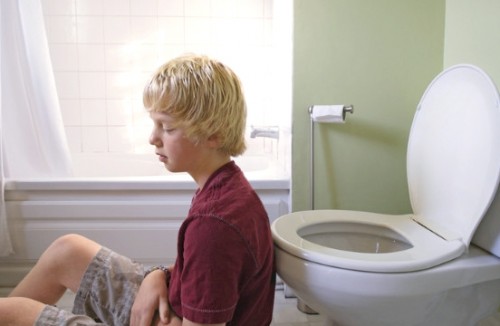Stomach “Flu” – Vomiting, Diahrrea and Norovirus
“Stomach flu,” what a name! A lot of people use the term but the gut-wrenching malady has absolutely nothing to do with “flu” – not caused by the same “bug,” transmitted differently, treated differently, not prevented by a vaccine and the cause of more confusion in people’s mind’s than probably any other term in medicine.
Use the term and most doc’s will need to waste time asking several more questions for clarification of what you mean. Leave the modifier “stomach” off when you’re talking to the doctor and he won’t have a clue what you’re talking about: Influenza or Gastroenteritis.
Stomach Flu – Huh?!
Influenza is the REAL “flu” – a highly contagious viral illness that rapidly mutates; infects the nose, lungs and bronchial passageways; excretes compounds that make you feel lethargic, weak and muscles ache; causes a fever; is transmitted on tiny water droplets (coughs) in the air and less so on surfaces; rarely causes vomiting or diarrhea (except in small children); is seasonal; can be prevented by vaccines and is the cause of massive, world-wide efforts to control it.
Gastroenteritis is an infection of the bowel tract which produces diarrhea and vomiting – does not infect the respiratory tract; rarely causes a fever; gives little muscle aches and pains (until your body gets dehydrated); is caused by many kinds of both viruses and bacteria; is transmitted in water, food, surfaces of objects, body surfaces; is not seasonal and always present; cannot be prevented by vaccines and doesn’t receive nearly as much “press coverage” as Influenza despite being massively deadly on a worldwide basis.
The two medical issues are definitely NOT the same thing; and in fact, they couldn’t be more completely different! Let’s talk about vomiting and diarrhea: Gastroenteritis – which, as you can see, gives absolutely no basis for the use of the term “flu”.
Gastroenteritis: Vomiting and Diarrhea
In the US (most developed countries) gastroenteritis is most often a “nuisance” disease – one which can debilitate but is fairly self-limiting, self-healing, requires little treatment and doesn’t last long.
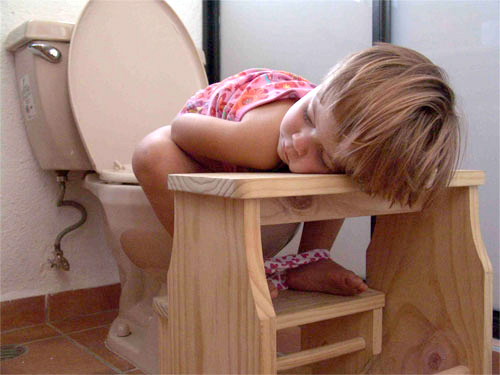 It can be caused by something as simple as dietary indiscretion but we’re not talking about that. Or, it can be caused by hundreds (or maybe even thousands) of different bacteria; from Shigella and Salmonella to the many strains of E Coli found in most people’s guts and stools. We’re not talking about those either.
It can be caused by something as simple as dietary indiscretion but we’re not talking about that. Or, it can be caused by hundreds (or maybe even thousands) of different bacteria; from Shigella and Salmonella to the many strains of E Coli found in most people’s guts and stools. We’re not talking about those either.
Several types of viruses cause “epidemics” of gastroenteritis, one of which are the Noroviruses and that is what we’re talking about here. Twenty-one MILLION illnesses each year for that virus alone; 70,000 hospitalizations and 800 yearly deaths according to the Centers for Disease Control and Prevention (CDC).
Unfortunately, there are many strains of the virus, so just because you may have contracted it once there is nothing to prevent you from getting the same disease caused by another strain in the future. One recent strain, GII.4 Sydney, ran through the US causing it’s vomiting, diarrhea and stomach cramps like wildfire. It was particularly prevalent in “care centers,” both child and adult.
A populace who is at least knowledgeable about, and capable of, personal sanitation and hygiene is critical in keeping the spread and devastation to a minimum in community outbreaks of this disease. Most of the deaths occur due to the dehydration that the disease can produce.
That’s the SECOND most important aspect you should be aware of, the FIRST being how to prevent it in the first place.
Prevention Strategies
Hand Washing
Hundreds of years of study hasn’t given us any more effective prevention than simple hand washing and other sanitary practices. Both you and your children (and even dad) should wash your hands often WITH soap and water. We’re not talking about a miniscule rinse and wipe, but a real suds with soap and for a full 20-30 seconds, after all we’re talking about thwarting an outbreak of bowel bugs! We’ve mentioned already that’s about two singing’s of “Happy Birthday” or “Twinkle Little Star.”
The term “Antibacterial” on the label is best and don’t think just washing only after YOU’VE gone to the bathroom is enough. During an epidemic those “fiendish thingys” are everywhere SOMEONE ELSE has gone to the bathroom and then put their hands! So, to prevent contracting the scourge, you’ve got to wash many more times than you usually would; pretty much after you touch anything that others have touched such as door knobs, etc.. And, definitely before you use your hands to touch food of put anything in your mouth.
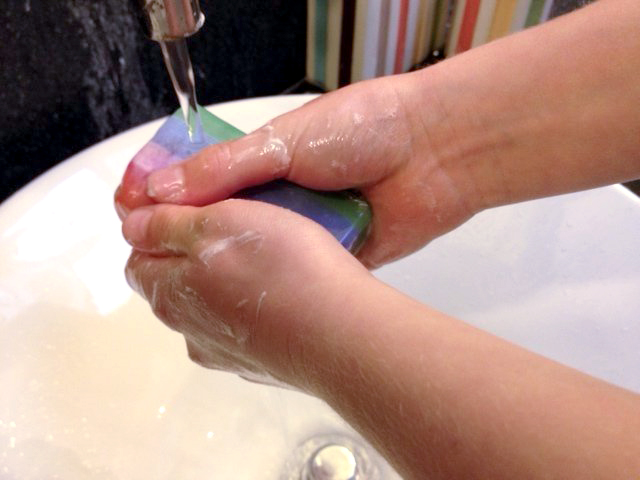 Even though they don’t eliminate Norovirus completely, hand sanitizers can help, especially if you’re traveling.
Even though they don’t eliminate Norovirus completely, hand sanitizers can help, especially if you’re traveling.
Break out the bleach
Bleach is the only thing you’ve probably got in your house that stands a chance of wiping out Norovirus living on surfaces.
If anyone in your household has gastroenteritis, or if you’ve had a visitor who you suspect is harboring it, that’s the time to heighten your “wipe down” frequency and thoroughness – unless you want it to run through your family too (pun intended). Dilute some bleach and wipe down any surface where virus may lurk, especially handles, doorknobs, refrigerator and don’t forget the many “remote controls” around your house.
Turn up the heat
Immediately put all clothes, towels or other linens which has contacted emesis (vomit) or feces (stool, poop) into the clothes washer. And if you don’t already, choose the hottest water setting and longest cycle that the machine has. This is a “special” occasion.
Dishwashers, the same thing. When trying to prevent illness, use the dishwasher instead of hand-washing them. The hottest water stands a better chance of neutralizing the virus.
Clean up your cooking
Washing fruits and vegetables before you eat, peel or slice them should be standard; but, with gastroenteritis in the neighborhood is even more critical. The CDC has reported more than a few outbreaks traced back to contaminated produce brought into the country or precipitated by food processors with inadequate quality control procedures.
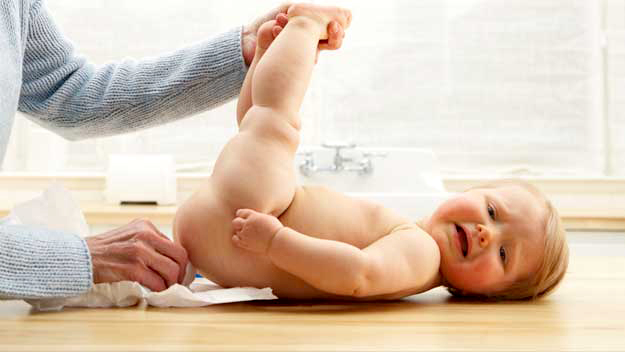 And be sure to cook all shellfish and produce thoroughly.
And be sure to cook all shellfish and produce thoroughly.
Change diapers with care
This is how it is spread people, and what gets epidemics going – fecal matter. Advice: stock your changing table with bleach-based cleaner and disposable gloves and change baby in the same place, ideally on a plastic surface you can clean easily. Post-change, wipe down the surface with bleach and bag the diaper in plastic before tossing it.
Keep them home
This should go without saying but in this fast-paced, goal-oriented world I think I should remind you: your sick child is an epidemic just waiting to get started with your kids name on it. Just think what it would mean if your kids virus was a mutation that went on to be “discovered” and then named after you. They often do that you know: “Norovirus GII.5 Johnny.”
Your son might think that would be way cool but how would you explain it to people at work? Especially since the local TV channels would obviously pick up the story. It’s just best to forgo the publicity and keep him home until he’s over it.
Even if he/she has stopped vomiting, keep them home from school, sports or play until they are drinking normally, without fever for at least 24 hours, not vomited for 48 hours and can control their bowels easily. Then put handy-wipes in all of their pockets before you send them out.
If you contract it yourself, you should delegate food preparation to someone else if at all possible. If not, extra precautions by wearing gloves and cleansing. Wait two to three days after your recovery to start preparing food again.
Treatment Strategies
Here’s what you’ll be doing for at least three to four days while the virus “runs” it’s course (again pun intended). Of course if you miss a prevention step listed above you may be doing this longer while it runs through your whole family.
Push fluids
While the virus is doing its thing the key treatment is making every effort to keep the child from getting dehydrated. That’s one of the factors that separates the developed countries, where the death rate is low, from the un- or under-developed countries where the death toll is unacceptably high.
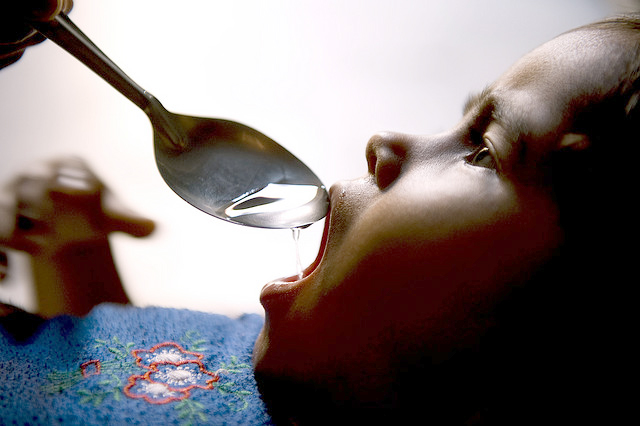 Most doctors have already given you a handout on how to treat fevers and gastroenteritis in children, follow their advice. In general, small, frequent sips of clear liquids containing water, sugar and electrolytes work best.
Most doctors have already given you a handout on how to treat fevers and gastroenteritis in children, follow their advice. In general, small, frequent sips of clear liquids containing water, sugar and electrolytes work best.
The trick is to get a child with a sick stomach to take sips even though he doesn’t feel like it. Sips only will do, any more and they may throw up. Offer small amounts in a glass, small chunks of frozen-pops or shaved-ice. Freeze your own cubes of electrolyte fluid or sports drinks.
When traveling
Infants and babies should pretty much stick with breast milk, formula or an infant/toddler rehydration solution like Pedialyte or Lytrin.
Toddlers should be offered Pedialyte or water.
Older children may sip sports drinks such as Gatorade.
Reintroduce foods carefully
It’s best to give the stomach a chance to “rest” before reintroducing foods. Wait a couple of hours after vomiting before re-instituting sips of liquids. Several hours or a day of tolerating liquids then Banannas, Rice cereal, Applesauce and weak, black Tea – the so-called BRAT diet.
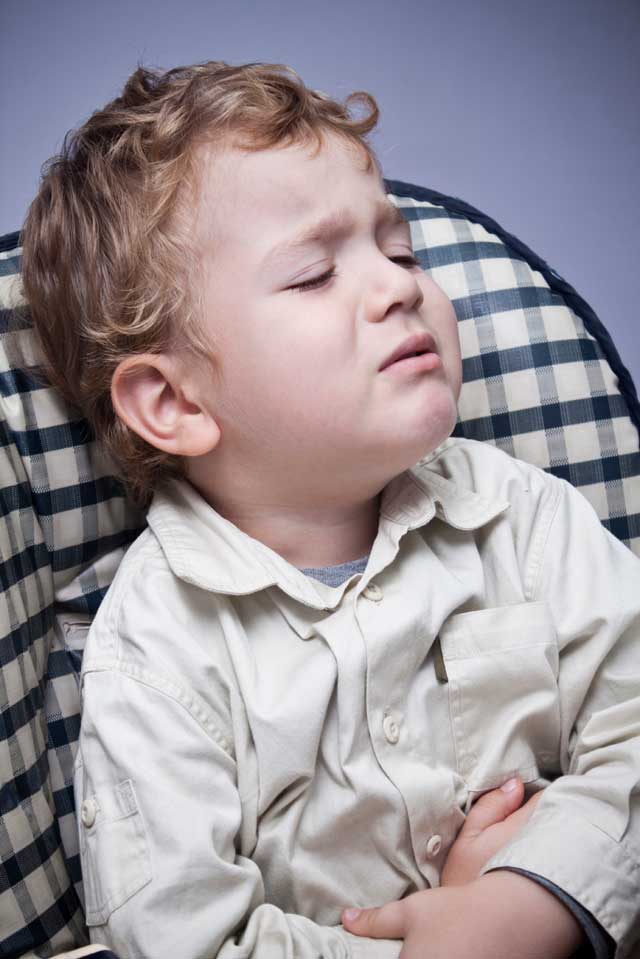 It should be noted that the BRAT diet isn’t what the internet seems to think: “just make up any food that begins with the four letters.” “T” is weak, black tea not toast – wheat products can trigger more diarrhea, “B” is not for bread, “A” is applesauce not apples which, again, may trigger more vomiting and diarrhea as the skins are digested etc.. Chicken and dumpling soup is not good, clear chicken bullion is. And it’s not “B” for bratwurst.
It should be noted that the BRAT diet isn’t what the internet seems to think: “just make up any food that begins with the four letters.” “T” is weak, black tea not toast – wheat products can trigger more diarrhea, “B” is not for bread, “A” is applesauce not apples which, again, may trigger more vomiting and diarrhea as the skins are digested etc.. Chicken and dumpling soup is not good, clear chicken bullion is. And it’s not “B” for bratwurst.
When they can tolerate liquids without throwing up they may be ready to try solids. If they begin vomiting again, then it’s back to sips of fluids. The diarrhea part, well you may just have to soldier through it for possibly several weeks before it resolves – especially in younger children and toddlers. The BRAT foods are used because they are normally constipating – that’s what you need.
If they can tolerate the BRAT diet items then you might progress to something the child is interested in as long as it’s along the lines of gelatin, crackers, Cheerio’s,pasta, rice and pretzels, avoiding milks, creamy or greasy foods.
Remember, the point is to first prevent dehydration then re-nourish slowly enough to prevent recurrence that would then prolong healing to the point of malnutrition; which, in itself, can lead to continued diarrhea.
Call the doctor
Watch your child’s mucous membranes (they should be moist) and urine (it should be light and odorless). Don’t wait until the urine is thick and dark yellow/brown to call the doctor. Call immediately if there are any signs of dehydration.
Other signs would be not keeping down fluids, having no tears when they cry and infrequent urination. A sunken soft spot is another serious sign of dehydration in an infant (under age 1). In older kids, watch for a serious lack of energy.
Prevention of dehydration is what we are trying to accomplish but that is not always possible with every child. If it occurs, then the earliest a doctor can intervene the easier it is to treat.
Most pediatricians appreciate a “heads up” call to their office during the day from parents who are battling illnesses like this with their children. They may be able to offer suggestions about what to watch for and when to call back – and even who to telephone if they are not taking call that evening.
Advertisement by Google
(sorry, only few pages have ads)

